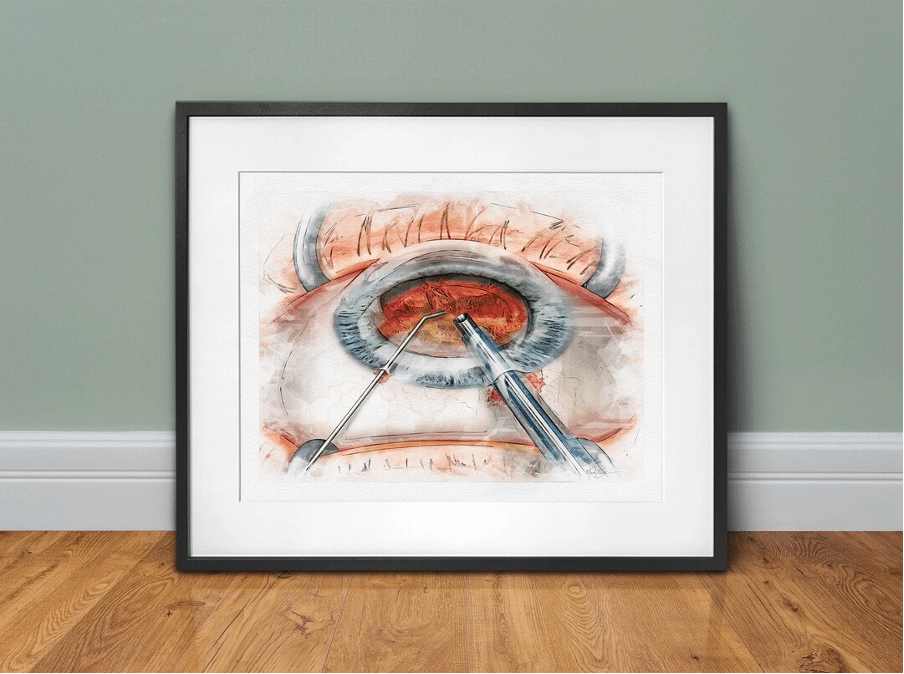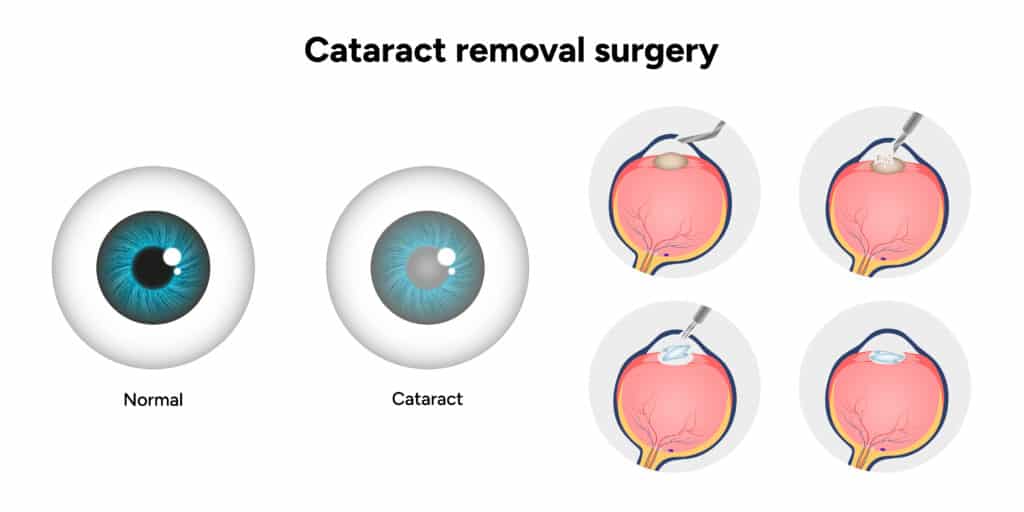You might ask how long cataract lenses last if you plan to get cataract surgery. The good news is that cataract lenses, or intraocular lenses (IOLs), can last your entire lifetime. Most patients never need to replace their cataract lenses after the surgery.
The success rate speaks for itself – 70% of patients get vision results within 0.5 diopters of their target. The procedure takes only 20-30 minutes and offers permanent benefits. Your doctor can choose from several types of cataract lenses based on your needs. These lenses use durable synthetic materials that prevent cataracts from returning. In this piece, you’ll find essential information about cataract lenses – from the surgical experience to ways you can maintain your better vision for years ahead.
Your journey through cataract surgery

Image Source: Etsy
Cataract surgery is a simple, painless procedure that happens in a hospital. Your surgeon will give you eye drops to dilate your pupil before the operation. This allows clear access to the cataract behind it. The procedure usually takes between 20 to 45 minutes. You should set aside four to six hours at the hospital on your surgery day.
Your surgeon will numb your eye with local anaesthetic through eye drops, an injection, or both. Most patients worry about pain, but you’ll stay awake and comfortable throughout the procedure. You might notice pressure changes or shifts in light and shade without any pain.
A tiny cut in your cornea starts the procedure. Most surgeons use a technique called phacoemulsification. An ultrasound probe breaks down the cloudy lens into tiny pieces that suction removes. Your lens capsule’s back portion stays in place as it provides the perfect spot for your new artificial lens.
Your vision starts getting better within days after surgery. Complete healing takes several weeks. You might experience mild discomfort, sensitivity to light, or slightly blurry vision at first. A gritty or scratchy feeling in the first 24 to 48 hours is common.
Recovery moves quickly for most patients. You can head home the same day but need someone else to drive you. Your surgeon will give you specific care instructions. These usually include using prescribed eye drops that prevent infection and reduce swelling. Remember not to rub your eye and wear a protective shield while sleeping during your original recovery period.
Types of cataract lenses and how to choose the right one
The right intraocular lens (IOL) for your cataract surgery depends on your visual needs, lifestyle, and budget. You’ll find several types of cataract lenses available, and each comes with its own benefits and things to think over.

Monofocal lenses are the most common choice that insurance typically covers. These lenses give you clear vision at one distance—either near, intermediate, or far. Most patients choose these for distance vision and use reading glasses for close-up work. Some patients go for monovision, where the surgeon sets one eye for distance and the other for near vision. This approach needs time to adjust.
Multifocal lenses work like bifocal or trifocal glasses with multiple focal points. These lenses help reduce your need for glasses, but you might notice glare or halos around lights at night. Trifocal lenses give you the most complete vision range. The trade-off is a higher chance of seeing visual disturbances at night.
Extended depth of focus (EDOF) lenses excel at distance and intermediate vision while helping with near vision too. The risk of seeing halos is nowhere near that of trifocal lenses. You might still need reading glasses, especially when you have dim light.
Toric lenses fix astigmatism and work well with other lens types. Approximately 94% of patients can see 20/40 or better at a distance without correction using these lenses.
Key factors to think about:
- Budget – Insurance usually covers standard monofocal lenses. Premium lenses cost extra, ranging from £1,191 to £6,000 per eye based on the type.
- Lifestyle needs – Your choice should match your daily activities, hobbies, and vision requirements.
- Existing eye conditions – Some eye diseases might limit your premium lens options.
Your surgeon will give you a full picture of your eye health through various tests. This helps determine your best lens option by checking corneal health, topography, and understanding what you expect from the surgery.
How long do cataract lenses last and what can affect them?
Modern cataract surgery offers a remarkable benefit – intraocular lenses (IOLs) last forever. Cataract lenses are designed to last a lifetime and stay in place permanently after implantation. These lenses don’t have any moving parts that could wear out, unlike other medical implants like joints. Doctors confidently use them even with young patients because they’re so durable.

Many patients ask about possible complications. The most common issue after surgery is posterior capsule opacification (PCO), which doctors often call a “secondary cataract”. This condition shows up in about half of all patients within five years after their surgery. It happens because cells grow on the membrane behind the new lens and create a cloudy film that makes vision blurry.
The good news? PCO has a simple fix. Doctors use a quick and painless procedure called YAG laser capsulotomy. This creates an opening in the cloudy capsule and brings back clear vision. Patients can go home the same day, and their vision usually improves within 24 hours. Other complications don’t happen as often. The lens might move out of position in rare cases – what doctors call IOL dislocation. People with certain genetic conditions like Ehlers-Danlos syndrome face a higher risk. The lens itself hardly ever gets cloudy with today’s modern lenses.
Looking to learn more about whether cataract lenses will last? Precision Vision London’s top eye surgeons can give you answers.
Only about 3% of patients need their IOL replaced. Doctors might recommend this if there are complications or if the lens power isn’t quite right. The vast majority of patients keep their original lenses forever. Your eyes need proper care after surgery. Wear sunglasses to block UV light, eat foods that support eye health, stay away from smoking, and see your eye doctor regularly. These simple steps help your cataract lenses work well throughout your life. Cataract lens implants stand as one of medicine’s greatest achievements. They’ve helped millions of people worldwide see better for the long term.
Conclusion
The lasting benefits of cataract lens surgery
Cataract lenses are a great way to get permanent relief from cataract-related vision problems. These implants last a lifetime, so you won’t need replacements later. Modern cataract surgery also lets you choose from several lens options that match your visual needs and priorities.
Some patients might develop posterior capsule opacification, but doctors can treat these complications with quick, non-invasive procedures. The numbers tell the success story – 70% of patients end up with vision within 0.5 diopters of their target.
Your new lenses need proper care to work their best. Regular eye checkups, UV protection, healthy eating habits and staying away from smoking will keep your vision sharp. These simple steps help maintain optimal lens function throughout your life.
Precision Vision London’s expert surgeons employ cutting-edge technology and give personalised care during your treatment experience. Your vision deserves exceptional quality and attention to detail. Picking experienced specialists becomes crucial to achieve the best results and enjoy clear vision for years.
Cataract surgery marks a turning point toward better quality of life. With good care and regular check-ups, your new intraocular lenses will serve you well for decades. You’ll see life’s precious moments with clarity and confidence.
FAQs
Q1. How long do cataract lenses typically last after surgery? Cataract lenses, or intraocular lenses (IOLs), are designed to last a lifetime. The vast majority of patients never need to replace their cataract lenses after surgery.
Q2. What types of cataract lenses are available? There are several types of cataract lenses, including monofocal lenses (for vision at one distance), multifocal lenses (for multiple focal points), extended depth of focus (EDOF) lenses, and toric lenses (for correcting astigmatism).
Q3. Is cataract surgery painful? Cataract surgery is generally a painless procedure. Patients receive local anaesthetic, either as eye drops or an injection, to numb the eye. You may feel some pressure or notice changes in light, but shouldn’t experience pain.
Q4. What is posterior capsule opacification and how is it treated? Posterior capsule opacification, often called a “secondary cataract”, occurs when cells grow on the membrane behind the new lens, causing cloudy vision. It’s treated with a quick, painless laser procedure called YAG laser capsulotomy, which typically resolves vision problems within 24 hours.
Q5. How can I maintain my eye health after cataract surgery? To maintain optimal eye health after cataract surgery, protect your eyes from UV light by wearing sunglasses, improve your diet, avoid smoking, and attend regular eye check-ups. These habits help ensure your cataract lenses continue functioning properly throughout your lifetime.
Authors & Reviewer
-
 Olivia: Author
Olivia: AuthorHi, I'm Olivia, a passionate writer specialising in eye care, vision health, and the latest advancements in optometry. I strive to craft informative and engaging articles that help readers make informed decisions about their eye health. With a keen eye for detail and a commitment to delivering accurate, research-backed content, I aim to educate and inspire through every piece I write.
-
 Dr. CT Pillai: Reviewer
Dr. CT Pillai: ReviewerDr. CT Pillai is a globally recognised ophthalmologist with over 30 years of experience, specialising in refractive surgery and general ophthalmology. Renowned for performing over 50,000 successful laser procedures.

